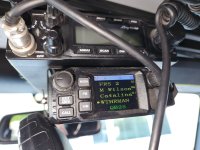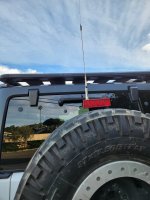This has been an interesting and complex topic. The more I read, the more I learn.
TL

R = buy the same radios as your buddies are already using. Don't use more power than needed.
LONG ANSWER:
"With great power comes great responsibility." Seems to be true for radios as well. The electromagnetic spectrum is a finite resource (like our public land trail system). Lots of people use it and we need to "tread lightly" on the radio spectrum just like on the land. If we all go FULL POWER we fill the airwaves with so much noise you step on each other and can't hear your group. Hence the FCC has rules.
Note: there is a safe harbor provision in the FCC laws that allow you to transmit on non licensed frequencies if there is an emergency.
The really good powerful VHF radios like the Icom require an FCC license. Pretty standard for business radios - these are used by local trucking fleets, warehouses, inside a refinery like mine, etc. As with most things - quality costs more money. For those that need it, it's worth it.
Unless your VHF radio stays on MURS frequencies only - MURS unlicensed means the operator of the radios does not need to file directly with the FCC to use the radio. The three frequency bands used for this in the U.S. are the
900 MHz, 2.4 GHz and 5.8 GHz.
VHF Marine radios and frequencies are specifically NOT allowed on land, so watch out for that. I live on the Gulf Coast where it's common to own both a boat and a jeep. The coast guard is picky about this for obvious safety reasons. Probably not something folks in the desert deal with.
The tricky thing is that it doesn't requires a license to BUY a radio. But you "may" need one to USE your radio. So it's very easy to break the law without realizing it. Note you only need a license to TRANSMIT. Receiving is always free. You can listen all you want to any frequency.
HAM - requires a license and you must pass a test. Lots of power, lots of options.
GMRS - requires a license, but no test. Just pay a fee and it's good for 10 years. Used to be $35, now it's $70 I think. And It's good for all your family (which might be the entire county in some locations - grin). max 5 watts on some frequencies, 50 on others.
FRS - no license. Max 2 watts on some frequencies, 0.5 watts on others so watch out. They are great for talking to the folks in your convoy if you stay within 1/2 a mile or so. Great for spotters which by definition are "line of sight." Handy for kids, camping, cruise ships, keeping track of youngsters at the mall. VERY HANDY during a disaster when cell phones are either down or saturated with too many users. We used them as we evacuated for a hurricane. I have 5 kids, 3 were teenage drivers, and we evacuated in 5 cars 100 miles in heavy traffic. Cell phones weren't reliable. FRS helped keep everyone aware and safe and coordinated bathroom stops, etc.
Note: GMRS and FRS share frequencies so you could mix them in a group and still talk to each other. BUT - the difference in power output can make the GMRS users REALLY LOUD, and the FRS users "really soft" so you are constantly playing with the volume in a mixed environment.
POWER - WATTS - more is better right? For handhelds you'll get longer battery life if you transmit with less power. You are also less likely to have cross talk interference with some other group if you are using low power. Plus, using the lowest power you need is a tread lightly nice thing to do. So it might make sense to have some low power FRS radios just for spotters and other line of sight work.
That way if you have a BIG convoy you can designate a high power frequency to talk longer distance from the front to the back - and designate a separate low power FRS frequency for spotters. And maybe a 3rd frequency for the kids to use, etc. a 4th for B.S. and trashtalk, LOL.
Which brings us back to the original TL

R = buy the same radios as your buddies are already using.



